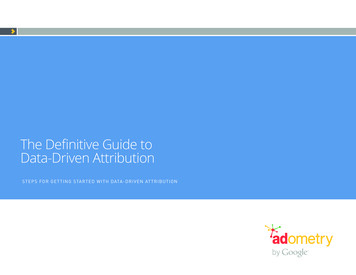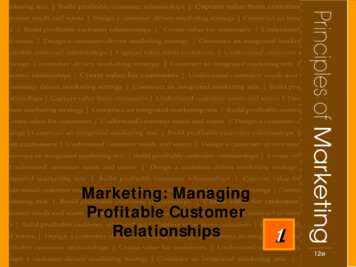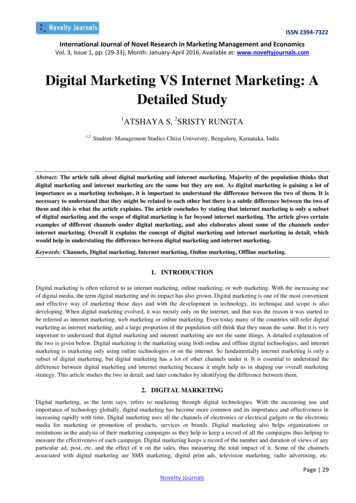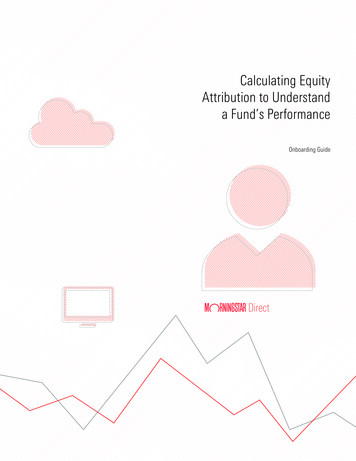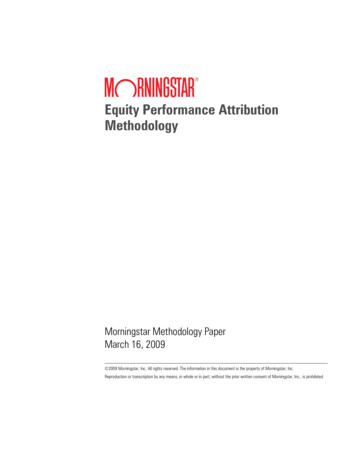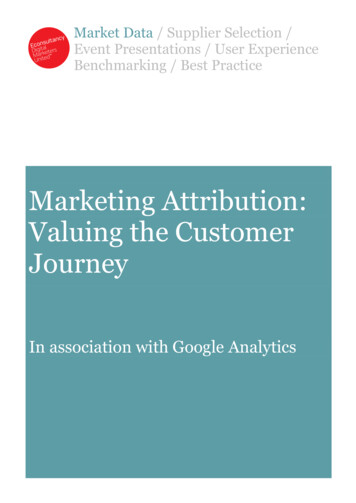
Transcription
Market Data / Supplier Selection /Event Presentations / User ExperienceBenchmarking / Best PracticeMarketing Attribution:Valuing the CustomerJourneyIn association with Google Analytics
Marketing AttributionValuing the Customer JourneyFebruary, 2012All rights reserved. No part of this publication may bereproduced or transmitted in any form or by any means,electronic or mechanical, including photocopy, recordingor any information storage and retrieval system, withoutprior permission in writing from the publisher.Copyright Econsultancy.com Ltd 2012Econsultancy London2nd Floor, 85 Clerkenwell RoadLondon EC1R 5ARUnited KingdomEconsultancy New York41 East 11th St., 11th FloorNew York, NY 10003United StatesTelephone: 44 (0) 20 7681 4052Telephone: 1 212 699 3626http://econsultancy.comhelp@econsultancy.com
Methodology and Respondent DemographicsThis paper is based on a study conducted by Econsultancy comprised of two elements.The first was a survey fielded to marketers and agencies between September 26 th andOctober 23rd of 2011, yielding 607 responses.The second phase of the research consisted of 22 telephone interviews with marketersand agencies using marketing attribution. Interviewees and their companies have beenkept anonymous to give them the latitude to openly discuss results, strategies and tactics.Respondents had the following attributes:Type of Respondent51% Client-side49% Agencies/consultantsRegion44% North America33% United Kingdom12% Europe (non-UK)6% APAC5% OtherAnnual Revenues8% Less than 1 million12% 1-10 million10% 10 – 50 million10% 50 – 150 million14% 150 million – 1 billion29% More than 1 billion17% Prefer not to answerTarget Market34% B2B49% B2C17% Both equallyIndustry14% Retail14% Financial Svcs10% Travel9% Publishing7% Manufacturing / Energy7% Professional Svcs6% Consumer Service4% Health/Pharma3% Education2% Insurance23% OtherUse of Attribution62% Marketers using attribution77% Agencies doing attributionTable of FiguresFigure 1: Goals for Attribution . 4Figure 2: Benefits of Attribution . 5Figure 3: Most Common Methods of Attribution . 6Figure 4: Primary Attribution Technologies. 8Figure 5: Effectiveness of Attribution Methods . 9Figure 6: Primary Impact of Attribution on Digital Spending . 10Figure 7: Changes to Channel Investments Resulting from Attribution . 11Figure 8: Barriers to Attribution / Keys to Success . 13Marketing Attribution: Valuing the Customer JourneyPage 1All rights reserved. No part of this publication may be reproduced or transmitted in any form or by any means, electronic or mechanical, including photocopy, recording or any information storageand retrieval system, without prior permission in writing from the publisher. Copyright Econsultancy.com Ltd 2012
Introduction from GoogleSavvy marketers understand that you don’t capture your audience with just one message,just one pretty picture, or just one perfectly placed advertisement. It’s a complex processof planting the seed, nurturing it, and finally harvesting the fruits of your marketingefforts. So when it comes to giving credit to the various elements of your marketingprogram – and, equally important, to making plans for your next campaign – it’sessential to take stock of all the factors that affected your results.Today, more and more marketers are turning to Marketing Attribution to give themvisibility into their successes and failures. We believe that the industry is just nowcoming to an inflection point – digital marketing has matured, and digital measurementis catching up. As you’ll see in this report, marketers recognize that the old ways ofmeasuring are no longer sufficient. Only 14% of respondents consider last-click analysis(which, until recently, has been the industry standard) to be "very effective." Yet over50% of them are still using last click measurement – most likely because they haven’t yetfound or mastered the right tools to take them beyond the last click.One of our core missions at Google is to create powerful and intuitive tools that makemeasurement easy, so that businesses can really use their data. In order to make theright decisions, advertisers and agencies need insight into which marketing efforts work,and which don’t. Digital advertising is often considered to be more accountable andefficient than any other form, thanks to important capabilities like online conversiontracking. But, as this study shows, conversion attribution must continue to evolve tobetter reflect how businesses really market their products and how consumers reallybehave. We look forward to seeing this evolution, and we’ll strive to provide the righttools to help make it happen.Bill KeeProduct ManagerGoogle AnalyticsMarketing Attribution: Valuing the Customer JourneyPage 1All rights reserved. No part of this publication may be reproduced or transmitted in any form or by any means, electronic or mechanical, including photocopy, recording or any information storageand retrieval system, without prior permission in writing from the publisher. Copyright Econsultancy.com Ltd 2012
Executive SummaryThe “customer journey” sounds linear, a trip from A to B. But the new reality is that ithappens across multiple sessions, sites and devices. Even relatively low cost products getdiscovered, researched, compared and purchased across multiple touch-points, inowned, earned and bought media. There are literally dozens of channels that caninfluence the sale.Marketing attribution is the practice of determining the role that channels play ininforming and influencing the customer journey. This research makes it clear that digitalchannels don’t operate independently. Their interplay is unique for every company andevery product.Marketers spend more on digital with each budget cycle, and they want to know how bestto allocate to a bewildering range of options. Typically, the tools available to them haveprovided visibility into the very top of the funnel (views, clicks, opens) and the bottom(sales, registrations, leads). Marketing and budget optimization have overlooked most ofthe funnel, where influence and research occur, and where 100% of opportunity getswhittled down to 2% conversion.Attribution offers the ability to understand how marketing affects the entire sales cycle,and to optimize across it. Unlike channel specific measurement, attribution doesn’t spitout binary results – paid search OR display. It describes the nuances of how display canimprove paid search results, or vice versa. Attribution jumps silos to analyze howchannels work in different circumstances, and how they work together.At its best, marketing attribution can also explore why channels work (or don’t)separately and together. By examining the way in which customers and prospectsinteract with media, marketers get to peer inside the customer journey. They see how thechannels assist one another, for example how email, SEO and social help a sale that gets“closed” by paid search. This analysis tells them about the customer, what they want andwhen, allowing further optimization.This report is the result of a two-stage study, combining the hard data of 607 client andagency side responses with the context of over 20 in-depth interviews with attributionprofessionals. Areas of inquiry included the benefits of attribution, approaches andtechnologies used, and the keys to success. For most companies that are engaged with it, attribution is still in its early stages.83% of the respondents to the survey who are doing attribution have been engaged inthe practice for less than 2 years. 28% began in just the last six months. Companiesare rapidly adopting attribution for a number of reasons, but the central one is that itoffers an accountability that internet marketing has promised but rarely delivered. Attribution is increasingly common at large organizations, and is moving into themid-market, whether as an in-house effort or as an expectation of an agency. At manycompanies, the practice begins with the desire to understand the interplay of naturaland paid search, but that spear tip leads to more and deeper analysis that goesbeyond SEM. None of the companies we interviewed were comfortable staying static(continuing to only evaluate search for example), and all were committed to continueusing attribution, despite its challenges.Marketing Attribution: Valuing the Customer JourneyPage 2All rights reserved. No part of this publication may be reproduced or transmitted in any form or by any means, electronic or mechanical, including photocopy, recording or any information storageand retrieval system, without prior permission in writing from the publisher. Copyright Econsultancy.com Ltd 2012
Access to the technology of attribution has pushed adoption past a tipping point.Built on the foundation of nearly universal web analytics adoption, attribution willlikely become standard within digital marketing departments in the mid-market andabove over the next few years. Attribution is a combination of technologies and processes that require knowledgeand skill from marketers or their agencies. Some organizations use nothing morethan spreadsheets, while others leverage sophisticated tools that assemble andanalyze data.However, an analysis of the methods used by experienced companies suggests thatover time they move toward more sophisticated solutions. Many companies start witha narrow last-click approach across channels, or by examining one channel acrossmultiple touchpoints. Enabled by technology, they are likely to migrate to a multiclick and cross funnel view. The ability to customize their analysis by weightingchannels based on experience is also key. At many organizations, attribution gets political. Redistributing budget is a necessaryby-product of understanding the interplay of channels. Changing the status quo isdifficult, especially at organizations where compensation is tied to the size of budgetsand bonuses. There’s a significant gap between the online and offline worlds. Organizations thatare attempting to cross the chasm between online and offline are rare; attributionefforts tend to be in the separate camps. Those that do combined attribution tend tolike what they find; powerful, complimentary effects by digital on offline, and viceversa.Still, the opportunities in digital alone are significant. Digital is poised to pass printspending for the first time in 2012, and it continues to grow while offline channelsebb, so making improvements in digital spending and understanding is vital. Eventhough most commerce takes place offline, for many sectors, the research anddecision-making process is mostly or entirely online. Attribution proves that no one size fits all. Lessons from one company, product orcampaign don’t necessarily port over to others. Factors change significantly overtime, so monitoring is an ongoing process – yet a process that an increasing numberof companies have deemed to be worth the effort.Marketing Attribution: Valuing the Customer JourneyPage 3All rights reserved. No part of this publication may be reproduced or transmitted in any form or by any means, electronic or mechanical, including photocopy, recording or any information storageand retrieval system, without prior permission in writing from the publisher. Copyright Econsultancy.com Ltd 2012
Marketing AttributionA Better UnderstandingWe’ve been working on client attribution long enough to have realized that a lot of our general assumptionsare sometimes dead wrong. Every client is different, every product is different. Just because display carried alot of weight in the last project doesn’t mean it will in the next one.Agency Analytics Manager focused on CPGFigure 1: Goals for AttributionHigh priorityJustifying digital spendingMedium priority62%Create most effectivemedia mix based on truevalue toward conversion57%Understanding funnel andsales cycle length to plancampaigns47%Correctly determiningaffiliate payments20%28%10%36%7%42%36%0%Low priority39%40%60%11%25%80%100%Number of respondents:179Marketers want to do more than simply justify their digital spend; they want to optimizeit. They’re looking to attribution to understand how different media perform so they canadjust the media mix and improve performance.Many practitioners of attribution also want to increase their knowledge of the salesfunnel and the sales cycle. In the long run, this goal might be the most important. Byexamining the way in which customers and prospects interact with an organization’searned, owned and bought media, marketers get to peer inside the customer journey.An additional goal for some respondents is to better understand how affiliates contributeto sales. For many retailers, affiliates get full compensation for simply providing acoupon used in the sale. Knowing that multiple channels collaborated to get users to thecoupon site gives marketers the ability to adjust affiliate payments and reallocate budget.Different People, Different LessonsAttribution was the missing piece to our campaign analysis. Now we don’t run a campaignwithout learning something about how our marketing affects the buying cycle, and then testingto see whether it applies in the long run. I feel like it’s made our buyer personas a lot morereal.now we think about the people who see and buy, the researchers, the email people.they’reall really different.Online Retailer, Fashion and Household GoodsMarketing Attribution: Valuing the Customer JourneyPage 4All rights reserved. No part of this publication may be reproduced or transmitted in any form or by any means, electronic or mechanical, including photocopy, recording or any information storageand retrieval system, without prior permission in writing from the publisher. Copyright Econsultancy.com Ltd 2012
Figure 2: Benefits of Attribution80%70%72%All respondents63%58%60%54%50%44%40%30%20%10%0%Better able toBetterallocate budget understandacrosshow digitalchannels and channels workROI istogether.improved.Providedinsights intoaudiencemakeup andbehaviors.Marketing isBetterbetterunderstand thepositioned torole ofobtain budget online/offlinedue to highermediaaccountability. interactions.Number of respondents:401The benefits of attribution match up with marketer goals, and in many cases, bringunexpected value. In Figure 2, we see that marketing organizations and agencies findmultiple benefits in their attribution efforts.Budget allocation is both the top goal and benefit of attribution, with over 70% ofrespondents citing it as the primary result of their program. Also aligned with top goals,attribution assists in understanding channel interaction and audience behaviour.The relationship between marketing and finance came up in several interviews. OneCMO described how the inclusion of attribution into the analytical mix changed thebudgeting process, bolstering the case for digital in general and establishing a new levelof accountability.Even though marketers are doing their best to cross-pollinate between digital andtraditional channels, a significant measurement gap remains. Of those markets withmulti-channel programs, only 41% cite being in a position to better understand theinteractions between digital and offline media.Not Just Another TechnologyIn a lot of cases, marketing technologies just complicate whatever you’re doing. Butattribution has been remarkably helpful. We always said digital was accountable, but we hadsuch a limited view that we were wrong most of the time.Marketing Manager, Online/Offline Consumer ServicesMarketing Attribution: Valuing the Customer JourneyPage 5All rights reserved. No part of this publication may be reproduced or transmitted in any form or by any means, electronic or mechanical, including photocopy, recording or any information storageand retrieval system, without prior permission in writing from the publisher. Copyright Econsultancy.com Ltd 2012
Attribution MethodsWhen we first dug into attribution for our multi-channel clients, the first lesson was that first and last-click justdidn’t describe reality. Learning the lessons about which channels complimented each other, in whatcases.that was huge, for us and for our clients.Client Strategy Lead, AgencyFigure 3: Most Common Methods of Attribution54%54%Last click - full credit is assigned to thelast interaction41%Customized by channel - certainchannels are weighted more/less heavily25%41%First click - full credit is assigned to thefirst interaction24%35%Unique methodology developed in-houseor by agency20%13%16%Unsure of method, but we do attributecredit by channelAgencies29%Linear - all interactions share evenly inthe creditClients10%Time decay - more credit is assigned tointeractions closer to the time ofconversion19%9%5%7%Other, please specify0%10%20%30%40%50%60%Number of respondents:401Figure 3 breaks out the methods used by marketers and agencies to determine the valueof individual channels and how they interoperate.The last-click method is the most popular, largely because it has been the most readilyavailable. In last click attribution, most or all credit is assigned to the final interactionprior to the desired event, but there are variations; Absolute last click – simply, the final event in the chain before a desired action (sale,registration, phone call, etc.), regardless of what that event is. Last non-direct click – this rewards the final event, but not if the event is “direct” –any click that does not have referral information. In these cases, there is no channelto credit, because the click came from an un-referable source, such as someone withcookies disabled, a bookmark, or some social URL shorteners. Last paid click – in some cases, marketers will tailor their attribution to reward thelast piece of paid media – pay per click search in many cases. For example, searchmarketers might choose to reduce or eliminate credit for organic search in cases ofMarketing Attribution: Valuing the Customer JourneyPage 6All rights reserved. No part of this publication may be reproduced or transmitted in any form or by any means, electronic or mechanical, including photocopy, recording or any information storageand retrieval system, without prior permission in writing from the publisher. Copyright Econsultancy.com Ltd 2012
branded and navigational searches. Some marketers also choose to give organic clickszero credit because it’s not easy or fast to affect organic search rankings – bycrediting the last piece of paid media, they focus on the tactics within their shortterm control.Last-click, and its mirror image, first-click, have the same limitation, offering a myopicview of what is often a complex multi-part interaction. The primary criticism of thesemethods is the over-crediting of channels at the Awareness and Purchase stages of thecustomer journey at the expense of those channels that contribute to Research andPreference stages.Linear and time-decay models try to reflect the complexity of digital marketing andthe interplay of the media that influence behavior but don’t always spark directpurchases. Social media and email often benefit from this holistic approach. Linearmodels grant credit more or less evenly depending on weighting, but include all of therecorded touchpoints that lead to a sale. In a time decay model, the events that occurclose to the sale are given more credit according to a general rule (e.g., events within thelast 7 days get 10pts) or formula (e.g., -10pts for each day before 24 hours prior to thesales event).Beyond the basic method chosen is the possibility of customization. The ability tocustomize is essential, because it’s a way for attribution to better reflect reality thanks tomarketers’ experience and knowledge of the unique aspects of their marketing. Thenuanced versions of last click mentioned above are a type of customization, but it can beapplied to any method. For example, a linear model might be tweaked to reflect thatorganic clicks in a certain date range share credit with an offline branding campaign. Or,marketers might apply a weighting system that tries to capture the full spectrum ofchannels involved, while giving more or less credit based on a historical understandingof their role in the sale.The complexity of modern marketing and marketing organizations make attribution achallenge when first approaching it. Silos between channels make it difficult to obtainand utilize a cross-media perspective in digital, let alone when offline channels areconsidered. As companies deal with these complexities, their ability to customizechannel weights within attribution methods becomes vital, so it is not surprising that wesee a high percentage of marketers and agencies citing customization as an importantattribution method.Marketing Attribution: Valuing the Customer JourneyPage 7All rights reserved. No part of this publication may be reproduced or transmitted in any form or by any means, electronic or mechanical, including photocopy, recording or any information storageand retrieval system, without prior permission in writing from the publisher. Copyright Econsultancy.com Ltd 2012
Attribution TechnologyAttribution tech is a hot topic, and we’re exploring. We’re probably never going to get totally rid of[spreadsheets], but the tech is getting much better at using the right information and giving us the latitude weneed.Analytics Manager, AgencyChanges in the technological landscape are enabling better and easier insight intochannel contributions. A new emphasis on attribution from some of the largestproviders of marketing services and technologies has given access to a much wider shareof companies than in past years. Note: Google Analytics is the sponsor of this report.In Figure 4, respondents describe their primary tool for marketing attribution, but it’sworth noting that like attribution methods (Figure 3), tools are often used in tandem.For example, an in-house method will incorporate or feed data from an outsourcedtechnology. Naturally, agencies are more likely to use varied methods, and to havedeveloped their own approach (or even technology).Figure 4: Primary Attribution TechnologiesAgencies9%Excel/spreadsheets17%32% 35%30%24%Externally built attributiontechnologyClientsCustom built, in-housetechnology25%Outsourced21%Number of respondents:347However, many client-side organizations also use multiple techniques and technologies.Among marketers, experience seems to be a key variable in sophistication. There’s acorrelation between the number of years an organization has been practicing attributionand the likelihood that they use multiple inputs and approaches.Combining Judgement With TechnologyOlder analytics [tools] just showed us [pieces].now we’re seeing the multi-touch pointanalytics and this is very helpful in terms of convincing people that we need attribution andthat it works. Over time you combine the technology with your own experience.Marketing Analytics Specialist, TravelMarketing Attribution: Valuing the Customer JourneyPage 8All rights reserved. No part of this publication may be reproduced or transmitted in any form or by any means, electronic or mechanical, including photocopy, recording or any information storageand retrieval system, without prior permission in writing from the publisher. Copyright Econsultancy.com Ltd 2012
No Silver BulletAttribution is complicated. Nothing gives you the full story, so you have to really understand your customersand assemble data and experience over time. We’re continually adding new layers of data and analysismethods, but it’s time consuming. It’s definitely worth it, but it’s time consuming and a work in progress for us.Survey Respondent, B2B Technology VendorFigure 5: Effectiveness of Attribution 40%20%29%27%23%14%14%First clickLast click0%Customized byUniquechannelmethodologyVery effectiveSomewhat effectiveLinearSomewhat ineffectiveVery ineffectiveNumber of respondents:179Every method has its devotees and detractors. Even the most customized methods areconsidered only “somewhat effective” by most of their practitioners.One consistent message from the data and interviewees alike is that attribution takesgood data, patience and hard work. Even as technologies have evolved to simplify andautomate parts of the process, so too has the understanding that the complexity of thecustomer journey defies easy answers.Marketing Attribution: Valuing the Customer JourneyPage 9All rights reserved. No part of this publication may be reproduced or transmitted in any form or by any means, electronic or mechanical, including photocopy, recording or any information storageand retrieval system, without prior permission in writing from the publisher. Copyright Econsultancy.com Ltd 2012
Spending and the Politics of AttributionThe elephant in the room is that attribution ultimately affects bonuses and the pockets of the people involved.You have to deal with the politics first or you won’t get buy-in, you’ll get resistance.Analytics Manager, Online RetailerFigure 6: Primary Impact of Attribution on Digital Spending60%Clients52% 51%Agencies50%40%30%23%20%10%14% 15%13%9%2%8%1%0%Decrease inspendingacross alldigitalmarketingchannelsDecrease inspending insome digitalmarketingchannelsNo impact ondigitalmarketingspendIncrease inspending insome digitalmarketingchannelsIncrease inspendingacross alldigitalmarketingchannelsNumber of respondents:401Understanding how channels affect sales through attribution means change at mostorganizations, and the most obvious is in how marketing distributes budget. Ideally,those changes should have everything to do with what’s working and how. For roughlyhalf of responding organizations, the model is working; 52% of client side marketersreport that attribution has led to an increase in spending on some digital channels.With most companies still using last-click attribution, changes to budgets are naturallygoing to be weighted toward activities at the bottom of the funnel – those channels thatare closest to the conversion event. As the industry becomes more sophisticated in itstechnology and methodologies, it’s likely that the approach to spending will becomemore sophisticated as well. The real promise is to fully understand the effects of activitiesacross the customer experience, and to optimize for all of the buying stages.Some companies aren’t built to take the best advantage of what they learn fromattribution. Rigid silos that separate tactics and people are the norm in many marketingdepartments. That structure doesn’t always support the kind of flexibility that’snecessary to take best advantage of optimization in general, and attribution in particular.Structural Barriers to OptimizationSiloed companies have political resistance to change of any kind, let alone something thatmight threaten numbers. One solution is to keep the attribution data fully in an independentanalytics group. From there it’s about propagation of the data, and hammering them with it.Director of Online Analytics, B2B Technology VendorMarketing Attribution: Valuing the Customer JourneyPage 10All rights reserved. No part of this publication may be reproduced or transmitted in any form or by any means, electronic or mechanical, including photocopy, recording or any information storageand retrieval system, without prior permission in writing from the publisher. Copyright Econsultancy.com Ltd 2012
Your Mileage May VaryI guess when we started, I was hoping that attribution would teach us lessons that we could apply indefinitelyand across campaigns and products. You definitely learn about how different channels work, but the reality isthat things keep changing and there are just too many variables to say that you’ve learned “the truth” aboutconsumer interactions. It’s like everything else; you’ve got to keep working on it.CMO, Financial Services PublisherFigure 7: Changes to Channel Investments Resulting from AttributionSignificant increase100%4%7%Some increase3%9%No changeSome decrease3%5%7%Significant %17%15%10%9%13%15%19%5%Number of respondents:179Figure 7 aggregates marketer responses to budget changes for specific online and offlinechannels. Although there are clearly patterns, it’s important to note that while manyorganizations have moved in a similar direction, in no case is that movement universal.Even in the example of print advertising, which has suffered for a variety of reasons,many organizations have kept their spending flat and some have increased it. Whileattribution lessons should never be applied without testing, the general trends areinteresting for where they agree and diverge from conventional wisdom. Digital Display – the surprising impact of digital display on search ROI and on brandlift was a recurring theme in the interviews.Marketing Attribution: Valuing the Customer JourneyPage 11All rights reserved. No part of this publication may be reproduced or transmitted in any form or by any means, electronic or mechanical, including photocopy, recording or any information storageand retrieval system, without prior permission in writing from the publisher. Copyright Econsultancy.com Ltd 2012
Television – it’s widely accepted that the role of television is shifting, but for the timebeing, it’s still the tactic that brand advertisers turn to most. Those conductingattribution studies are more than twice
coming to an inflection point - digital marketing has matured, and digital measurement is catching up. As you'll see in this report, marketers recognize that the old ways of . Access to the technology of attribution has pushed adoption past a tipping point. Built on the foundation of nearly universal web analytics adoption, attribution .






